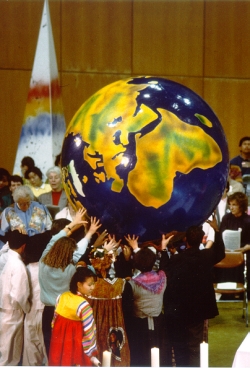Broadly, this concept draws attention to the tendency for groups of intellectuals to become totally absorbed in the logical puzzles of a particular theory. When outside change occurs, then the intellectuals have to be wrenched reluctantly back from metaphysical speculation to the problems of the real world and a new theoretical formulation, or paradigm, may become dominant. For instance, the intricacies of a theory suitable for an economy based on steam technology with small-scale firms run by owner-managers will not be suitable for large-scale, multinational, joint-stock corporations operating in the nuclear age. (Cole et al, Why Economists Disagree, pp.11-12)This is what is called a "paradigm shift," though Kuhn himself, was reluctant to apply his theory to social science. A decade or so later, Konrad Raiser applied the theory of paradigm shift to the ecumenical movement in his book, Ecumenism in Transition. In his book, Raiser contended that the old paradigm of the ecumenical movement is being superceded by a new one. The old paradigm Raiser characterises as "Christocentric universalism", marked by "the Christocentric orientation, concentration on the church, a universal perspective, and history as the central category of thought" (p.41). Against this background, Raiser identifies three main emphases for a new paradigm: a Trinitarian understanding of the divine reality and of the relationship between God, the world and humankind; "life", understood as a web of reciprocal relationships, as a central point of reference (instead of history); and an understanding of the one church in each place and in all places a fellowship in the sense of a community of those who are different from one another (p.78). Central to this new paradigm is an understanding of the oikoumene as a household, an "oikos", the "one household of life created and preserved by God, that extends beyond the world of humankind, of the one human race, to creation as a whole" (pp.87-8). Elements of this new paradigm could be observed in the 1990s in the WCC in such areas as the "Theology of Life" programme, the process to develop a Common Understanding and Vision for the WCC, and in Raiser's WCC general secretary report to the 1998 Harare assembly.
Raiser drew up his sketch of a new paradigm for the ecumenical movement shortly before the series of events at the end of the 1980s that marked, in one sense, the end of the post-war world of which the WCC was part. Konrad Raiser's sketch of an emerging paradigm was aimed at doing justice to an ecumenism of diversity. Yet both the old and the new paradigms identified by Raiser had one thing in common: both are an attempt to explicate the significance of the ecumenical movement through a comprehensive meta-narrative. Yet one challenge identified as facing the WCC and the ecumenical movement since 1989 has been precisely the lack of a such a paradigm, recognised and accepted by all participants. As Minna Hietamäki noted in her presentation to the Faith and Order plenary commission in 2009:
The unity and diversity of the Church cannot be separated from the concrete contexts and the concrete web of relations where the relations exist. As in the koinonia-relations described earlier, also in concrete life situations we are faced with relations which can be described by mutual dependency, where logical priority or priority-in-status does not destroy the mutual indwelling and which are not interchangeable. This leads me to the practical challenge that follows from describing the Church as essentially diverse in its unity. If we are not to fall into an unspecific pluralism, we need to retain the possibility to say and show what is and what is not properly Christian. But how is it possible to identify the “true Christian community” when the Church’s oneness can essentially be described only by diversity that reaches from the very being of God to the variety of cultural and linguistic contexts and when the essence of the community lies in noninterchangeable relations?






